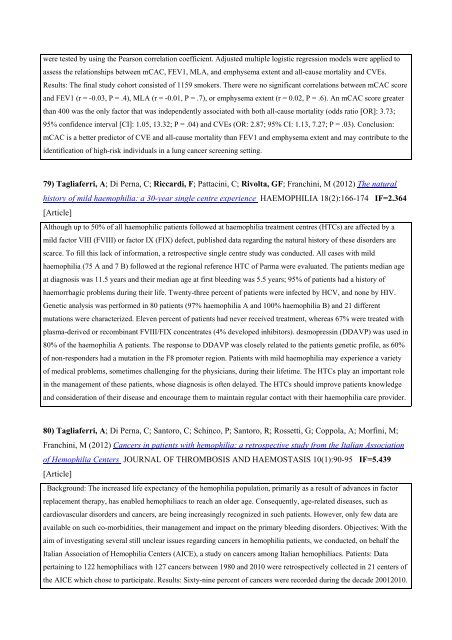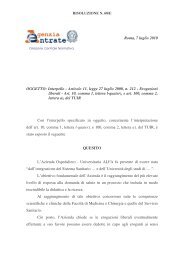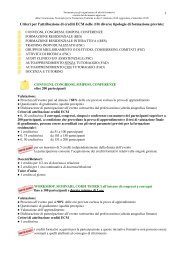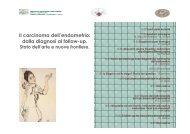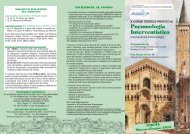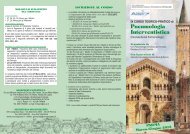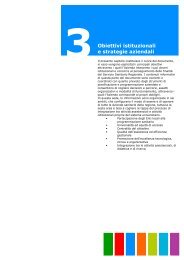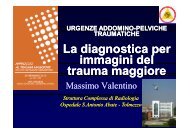COLLEGIO DI DIREZIONE - Azienda Ospedaliera di Parma
COLLEGIO DI DIREZIONE - Azienda Ospedaliera di Parma
COLLEGIO DI DIREZIONE - Azienda Ospedaliera di Parma
You also want an ePaper? Increase the reach of your titles
YUMPU automatically turns print PDFs into web optimized ePapers that Google loves.
were tested by using the Pearson correlation coefficient. Adjusted multiple logistic regression models were applied to<br />
assess the relationships between mCAC, FEV1, MLA, and emphysema extent and all-cause mortality and CVEs.<br />
Results: The final study cohort consisted of 1159 smokers. There were no significant correlations between mCAC score<br />
and FEV1 (r = -0.03, P = .4), MLA (r = -0.01, P = .7), or emphysema extent (r = 0.02, P = .6). An mCAC score greater<br />
than 400 was the only factor that was independently associated with both all-cause mortality (odds ratio [OR]: 3.73;<br />
95% confidence interval [CI]: 1.05, 13.32; P = .04) and CVEs (OR: 2.87; 95% CI: 1.13, 7.27; P = .03). Conclusion:<br />
mCAC is a better pre<strong>di</strong>ctor of CVE and all-cause mortality than FEV1 and emphysema extent and may contribute to the<br />
identification of high-risk in<strong>di</strong>viduals in a lung cancer screening setting.<br />
79) Tagliaferri, A; Di Perna, C; Riccar<strong>di</strong>, F; Pattacini, C; Rivolta, GF; Franchini, M (2012) The natural<br />
history of mild haemophilia: a 30-year single centre experience HAEMOPHILIA 18(2):166-174 IF=2.364<br />
[Article]<br />
Although up to 50% of all haemophilic patients followed at haemophilia treatment centres (HTCs) are affected by a<br />
mild factor VIII (FVIII) or factor IX (FIX) defect, published data regar<strong>di</strong>ng the natural history of these <strong>di</strong>sorders are<br />
scarce. To fill this lack of information, a retrospective single centre study was conducted. All cases with mild<br />
haemophilia (75 A and 7 B) followed at the regional reference HTC of <strong>Parma</strong> were evaluated. The patients me<strong>di</strong>an age<br />
at <strong>di</strong>agnosis was 11.5 years and their me<strong>di</strong>an age at first blee<strong>di</strong>ng was 5.5 years; 95% of patients had a history of<br />
haemorrhagic problems during their life. Twenty-three percent of patients were infected by HCV, and none by HIV.<br />
Genetic analysis was performed in 80 patients (97% haemophilia A and 100% haemophilia B) and 21 <strong>di</strong>fferent<br />
mutations were characterized. Eleven percent of patients had never received treatment, whereas 67% were treated with<br />
plasma-derived or recombinant FVIII/FIX concentrates (4% developed inhibitors). desmopressin (DDAVP) was used in<br />
80% of the haemophilia A patients. The response to DDAVP was closely related to the patients genetic profile, as 60%<br />
of non-responders had a mutation in the F8 promoter region. Patients with mild haemophilia may experience a variety<br />
of me<strong>di</strong>cal problems, sometimes challenging for the physicians, during their lifetime. The HTCs play an important role<br />
in the management of these patients, whose <strong>di</strong>agnosis is often delayed. The HTCs should improve patients knowledge<br />
and consideration of their <strong>di</strong>sease and encourage them to maintain regular contact with their haemophilia care provider.<br />
80) Tagliaferri, A; Di Perna, C; Santoro, C; Schinco, P; Santoro, R; Rossetti, G; Coppola, A; Morfini, M;<br />
Franchini, M (2012) Cancers in patients with hemophilia: a retrospective study from the Italian Association<br />
of Hemophilia Centers JOURNAL OF THROMBOSIS AND HAEMOSTASIS 10(1):90-95 IF=5.439<br />
[Article]<br />
. Background: The increased life expectancy of the hemophilia population, primarily as a result of advances in factor<br />
replacement therapy, has enabled hemophiliacs to reach an older age. Consequently, age-related <strong>di</strong>seases, such as<br />
car<strong>di</strong>ovascular <strong>di</strong>sorders and cancers, are being increasingly recognized in such patients. However, only few data are<br />
available on such co-morbi<strong>di</strong>ties, their management and impact on the primary blee<strong>di</strong>ng <strong>di</strong>sorders. Objectives: With the<br />
aim of investigating several still unclear issues regar<strong>di</strong>ng cancers in hemophilia patients, we conducted, on behalf the<br />
Italian Association of Hemophilia Centers (AICE), a study on cancers among Italian hemophiliacs. Patients: Data<br />
pertaining to 122 hemophiliacs with 127 cancers between 1980 and 2010 were retrospectively collected in 21 centers of<br />
the AICE which chose to participate. Results: Sixty-nine percent of cancers were recorded during the decade 20012010.


